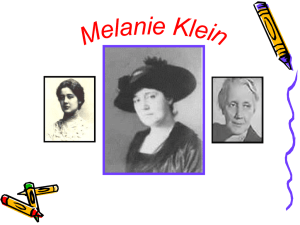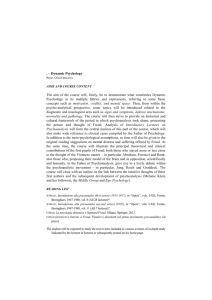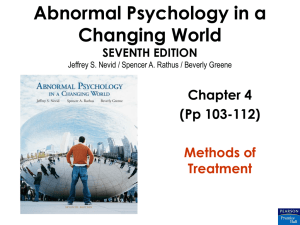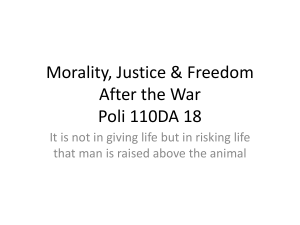The Story of Psychology
advertisement
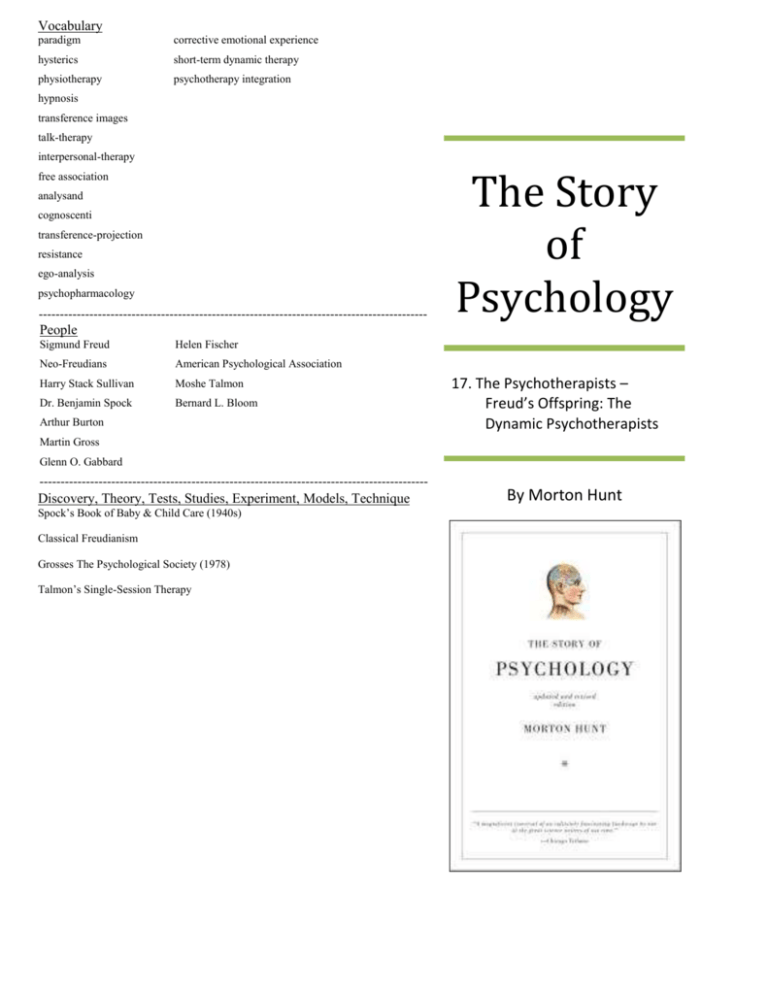
Vocabulary paradigm corrective emotional experience hysterics short-term dynamic therapy physiotherapy psychotherapy integration hypnosis transference images talk-therapy interpersonal-therapy free association analysand cognoscenti transference-projection resistance ego-analysis psychopharmacology -------------------------------------------------------------------------------------------People Sigmund Freud Helen Fischer Neo-Freudians American Psychological Association Harry Stack Sullivan Moshe Talmon Dr. Benjamin Spock Bernard L. Bloom Arthur Burton The Story of Psychology 17. The Psychotherapists – Freud’s Offspring: The Dynamic Psychotherapists Martin Gross Glenn O. Gabbard -------------------------------------------------------------------------------------------Discovery, Theory, Tests, Studies, Experiment, Models, Technique Spock’s Book of Baby & Child Care (1940s) Classical Freudianism Grosses The Psychological Society (1978) Talmon’s Single-Session Therapy By Morton Hunt The Story of Psychology by Morton Hunt 17. The Psychotherapists – Dynamists Dynamic Psychology as a Paradigm 1. What is the “one legitimate generalization,” according to Hunt? 2. What are the components of psychological problems as Hunt defines them? 3. What did Freud discover to be the most effective treatment of hysterics? Words You Need to Know 4. paradigm 5. hysterics 6. physiotherapy 7. hypnosis Origins of Psychoanalysis (psychotherapy), 1890s – 1930s 8. Where did psychoanalysis first develop and at that time what was most prevalent in the United States? 9. What effect did World War I have on psychotherapy? 10. What influence did psychiatry have on the establishment of psychoanalysis in the United States? 11. What role was played on psychoanalytic development in the U.S. by the rise of Nazism in the 1930s? The Story of Psychology by Morton Hunt 17. The Psychotherapists – Dynamists Neo-Freudians 12. What made them “Neo” or “New” Freudians (what did they do different than Freud)? 13. Describe the difference between Sigmund Freud’s free-association technique and Harry Stack Sullivan’s interpersonal therapy. 14. What was the typical or preferred regime of therapy? Words You Need to Know 15. free association 16. transference images 17. interpersonal therapy World War II & the Post War Years 18. What effect was had on the therapy profession by the war? 19. How was psychoanalysis popularized during this period? 20. According to Hunt, what was the role of Dr. Benjamin Spock’s Book of Baby and Child Care? 21. What were some problems with psychoanalytic therapy regarding service statistics? The Story of Psychology by Morton Hunt 17. The Psychotherapists – Dynamists Words You Need to Know 22. analysand 23. cognoscenti Quotes You Need to Know 24. To what was Erik Erikson referring when he said “Even as we were trying to devise a therapy for the few, we were led to promote an ethical disease for the many?” Classical Freudianism 25. According to Hunt, how did people begin to feel about the Classically trained Freudians? 26. Describe the basic goal of the Classic Freudian therapy? 27. What are the three processes that would require a Classical Freudian to speak? 28. What infuriated many patients who were treated by Classical Freudians? 29. What did humorists and satirists like to pick out regarding Classical Freudian treatment? Words You Need to Know 30. transference-projection 31. resistance The Story of Psychology by Morton Hunt 17. The Psychotherapists – Dynamists Quotes You Need to Know 32. What do you think is the strategy associated with the Classic Freudian therapeutic questions, “Why does that seem important to you,” and “Why do you think I would feel that way?” 33. One therapist wrote about a female patient “who bawls me out unmercifully almost every hour, calling me immature, a quack, cold, a sex maniac, and so on, yet at the end of the hour she gives me a deep, longing look and says softly, See you next time.” Is she transferring (projecting), resisting, or both? Explain. Who Are the Psychoanalysis? 34. How does Hunt describe them? 35. What did Arthur Burton say to them in his volume of autobiographies? 36. How was that portrait different from Martin Gross’s “vitriolic assault” in his 1978 book, The Psychological Society? 37. By the 1950s where were many Freudians shifting in their methodology? Words You Need to Know 38. ego-analysis Rebellion & Conservativism, 1960s – 1990s 39. According to Glen O. Gabbard, of what was psychoanalysis unjustly accused in the 1960s? 40. According to the Helen Fischer and the American Psychological Association, what had happen to psychoanalysis by the 1990s? The Story of Psychology by Morton Hunt 17. The Psychotherapists – Dynamists Currently 41. Has the psychoanalysis continued to shrink since the 1990s or has it made a comeback? 42. According to Dr. Glenn O. Gabbard, why would Freud not recognize psychoanalysis today? 43. How are modern-day practitioners of psychoanalysis different from their classically trained predecessors? 44. What does Hunt conclude about those who practice “nonanalytic psychotherapy? 45. Describe the therapeutic experience of Bernice Hunt’s patient? Words You Need to Know 46. psychopharmacology 47. corrective emotional experience Variations of Psychoanalysis 48. Describe the approach of short-term dynamic therapy. 49. How long does short-term dynamic therapy take and what successes have been reported? 50. What claim was made Bernard L. Bloom regarding the effectiveness of “brief psychotherapy?” 51. What is psychotherapy integration? The Story of Psychology by Morton Hunt 17. The Psychotherapists – Dynamists The discipline of cognitive science includes psychology and neurology, what you have read about is those two fields interest in the specific phenomenon of psycholinguistics. Ensuring that your essay has all the necessary components, answer the following question: As discoursed by Morton Hunt, trace the ebb and flow of psychoanalysis in the United States beginning with its origins in the World War I period.





